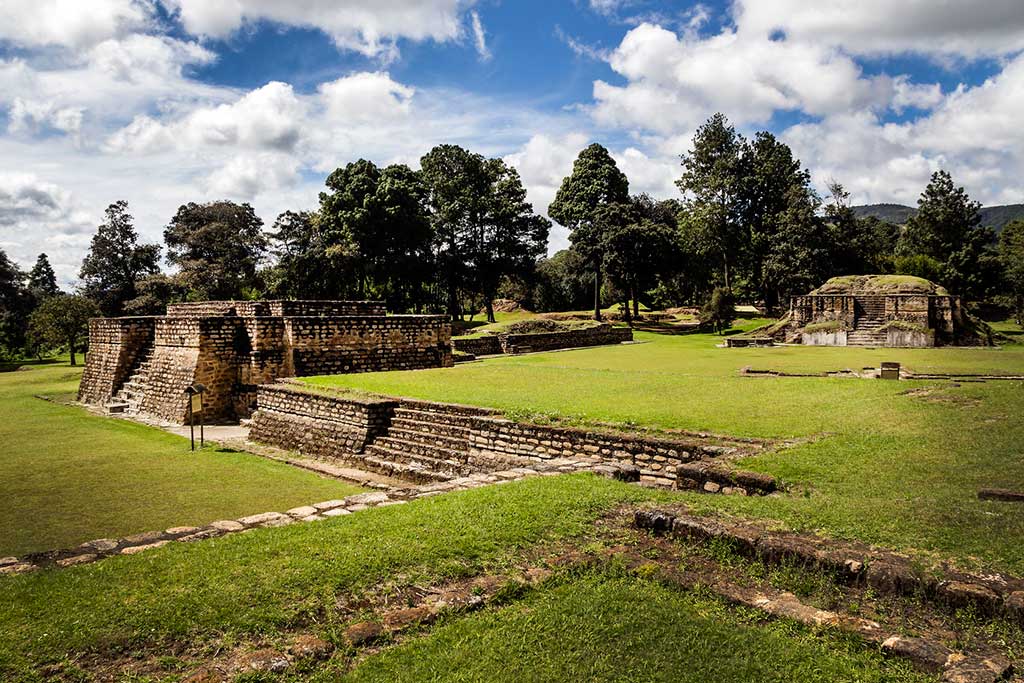Faced with the increasingly belligerent expansionist aims of their K’iche’ rivals, the Kaqchikel moved their capital from present-day Chichicastenango to the more easily defended site of Iximché, surrounded on three sides by ravines, sometime around AD 1470. Like many other Mayan sites, it bore strong influence from present-day Mexico, an influence evident in its Nahua name, Cuauhtemallan, a derivative of which eventually gave the country its modern-day name meaning “land of many trees.” Societal organization here was based on lineages, with evidence of bitter rivalry between different lineages including ritual cannibalism and human sacrifice. The new capital had been established for only about 50 years before the arrival of the Spanish, who would enlist the Kaqchikel as allies in their quest to conquer the K’iche’ and other Mayan peoples of the Western Highlands.

Iximché exhibits much more of a Mexican influence than other Maya sites in Guatemala. Photo © Michal Zak/123rf.
The new capital had been established for only about 50 years before the arrival of the Spanish, who would enlist the Kaqchikel as allies in their quest to conquer the K’iche’ and other Mayan peoples of the Western Highlands.After the highlands were fully conquered, the Spanish established the first capital of Guatemala here on July 25, 1524. Alvarado, however, began demanding excessive tribute and the Kaqchikel soon revolted, eventually fleeing the town after Alvarado finally burned it to the ground. From the surrounding countryside (demonstrating a remarkable symmetry to the country’s more recent history), the Kaqchikel launched a guerrilla war against the Spanish that lasted until 1530.Iximché (various transport, 10 minutes from Tecpán, 8am-5pm daily, $3.50) is the most easily accessible of Guatemala’s highland Mayan ceremonial sites and makes an interesting stop for those with an interest in Mayan culture and history because of the differences it exhibits from the lowland Mayan sites of Petén, which date to much earlier times. Like many remoter highland counterparts (Mixco Viejo, K’umarcaaj, and Zaculeu), it was built on an isolated bluff surrounded and protected by ravines. Its smaller structures also exhibit much more of a Mexican influence, attesting to the population of the Guatemalan highlands by Toltec groups coming from the area near present-day Veracruz.
In March 2007, Iximché made a convenient stopover for President George W. Bush, the first lady, Laura Bush, and their Guatemalan hosts Oscar and Wendy Berger on their way back to Guatemala City from a visit to a nearby vegetable farming cooperative. They received a red carpet welcome of sorts, entering the ruins’ main plaza on a specially made alfombra similar to the ones created for Antigua’s Holy Week processions. They were also treated to a marimba band, an exhibition of the Mayan ball game, and a traditional dance performed by local children. In an impromptu display rarely seen in international protocol, Presidents Bush and Berger even attempted to play some ball of their own before members of the Secret Service rushed them on to the next order of business.
Of the ruined temple pyramids, only a few features stand out. The small altar at the base of Temple II, on Plaza A, has faint traces of murals. Other features include two ball courts and Plaza B, which housed royals. The museum has some interpretive displays predominantly on Pedro de Alvarado and the Kaqchikel uprisings. There’s also a 1:200 scale model of Iximché based on an 1882 map created by Alfred Maudslay. To get here, turn off the main highway to Tecpán. From the town center there are buses, minibuses, and taxis heading out to the ruins, less than 10 minutes away.
Excerpted from the Fifth Edition of Moon Guatemala.